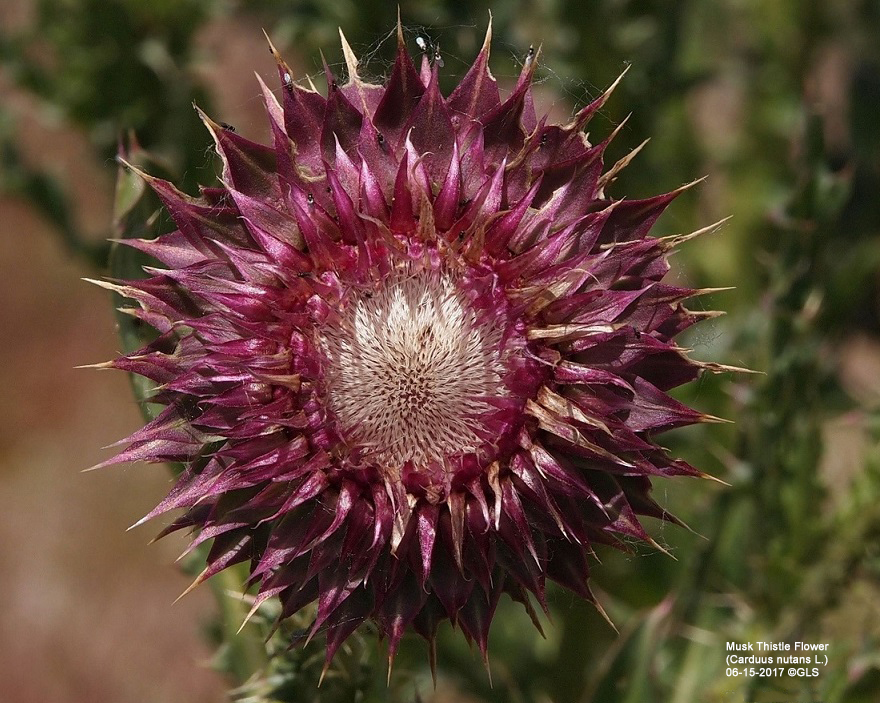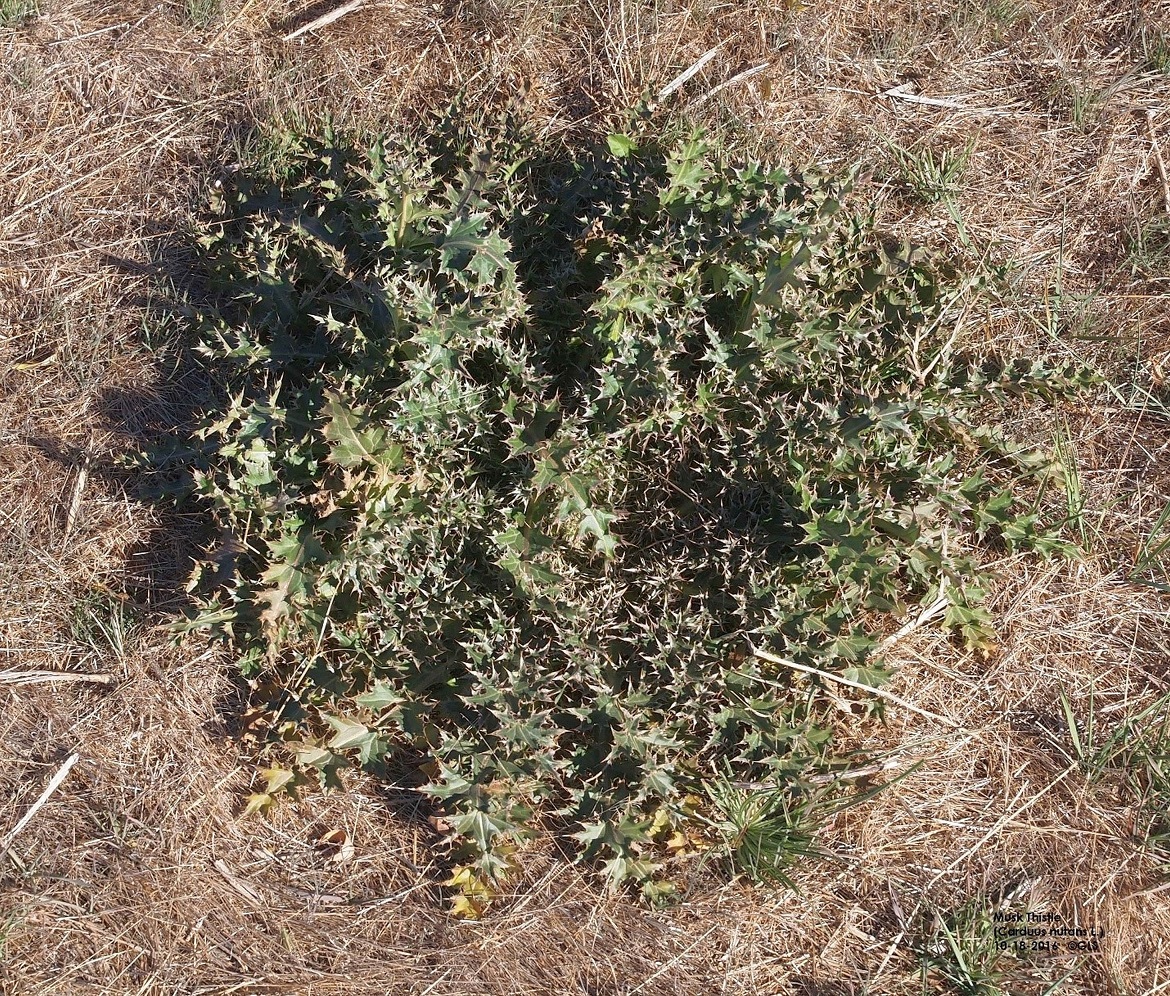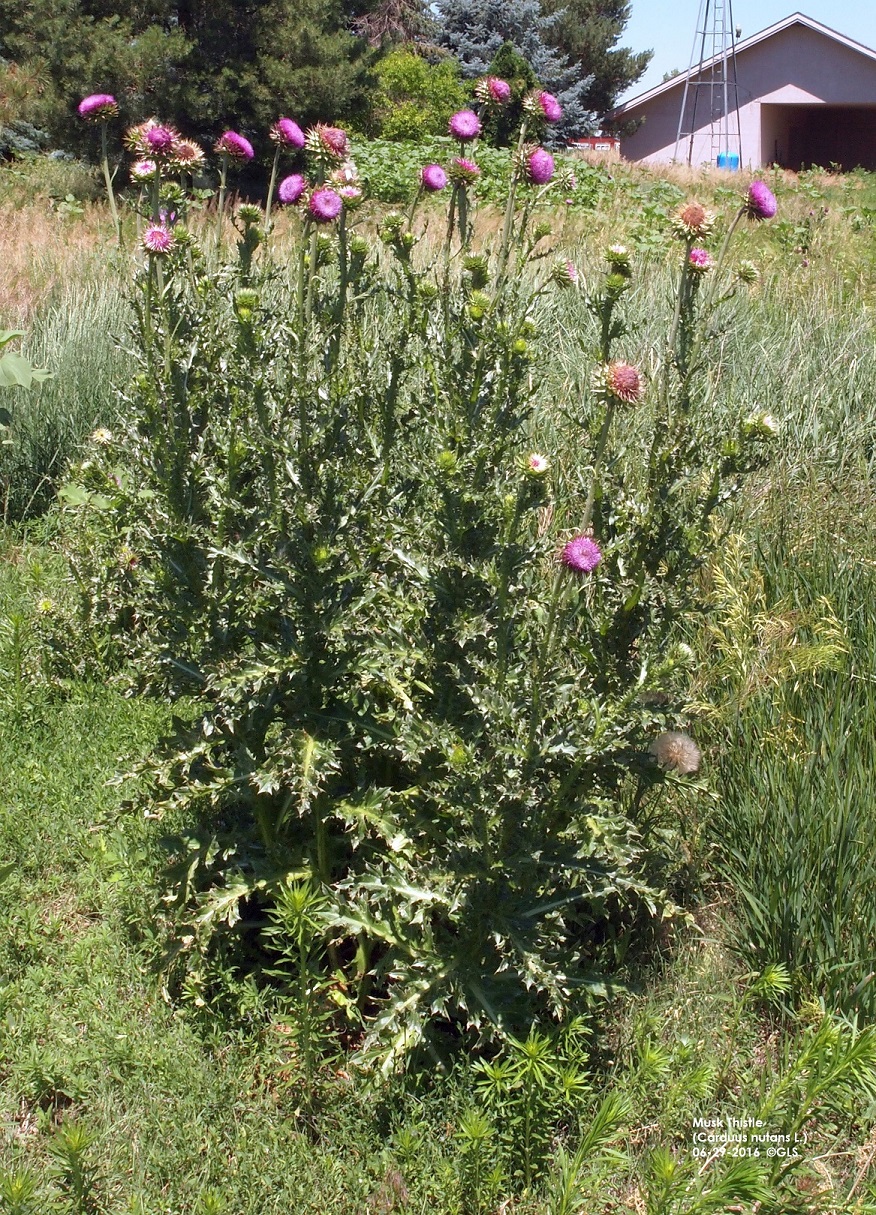Gary Stone, Nebraska Extension Educator

Early Detection and Rapid Response (EDRR) is a concept to identify potentially invasive species prior to or just as the establishment of the invasive is taking place. An Integrated Pest Management plan (IPM) can be developed to manage, contain and eradicate the invasive species before it can spread further. This will avoid costly, long-term control efforts.
Musk Thistle
a.k.a. – Nodding thistle, Nodding Plumeless thistle
Scientific name: Carduus nutans L.
Family: Asteraceae (Sunflower family)
Description
Origin: Eurasia. Introduced into the United States as an ornamental plant in the mid 1800s.
Musk thistle is a non-native biennial forb but can behave occasionally as an annual. It reproduces/spreads from seed. Musk thistle is a prolific seed producer. Each thistle plant can produce 10,000 up to 120,000 seeds. Germination of seed and emergence of seedlings can occur anytime and are correlated with light and moisture. Optimum germination will take place in moist soil with 59° to 68°F soil temperature in the light and 68° to 86°F in the dark. Approximately one third of the seeds produced are viable. Viability of the seed varies. Water, wind, livestock, wildlife, vehicles and humans disperse seed.
Musk thistle forms a rosette the first year and then bolts the second year to produce flowering stalks and has a taproot. Plants are usually two to six feet tall or taller. Flowering and seed production can start 45 to 55 days after bolting. Leaves are generally dark green with a light colored mid-rib and deeply segmented. Flowers have sharp spiny bracts under them and the shoots beneath the flowers do not have leaves. Musk thistle produces many seed heads. The terminal or tallest shoots flower first and the lateral shoots later. Musk thistle can have different stages of floral development and senescence.


Habitat
Musk thistle is found in any type of habitat but normally establishes quickly in disturbed areas dominated by annual plants such as cheatgrass. It can also be found in over-grazed sites, roadsides, and riparian areas. Musk thistle is found across most of North America. It can invade healthy, undisturbed sites as well, out-competing desirable forbs and grasses in pastures and rangeland and reducing biodiversity. Musk thistle is not palatable to livestock.
Management
Musk thistle is a designated noxious weed under the Nebraska Department of Agriculture’s Noxious Weed Program. Prevention is the best and cheapest management option. Having well-established perennial grasses and forbs on a maintained pasture or rangeland with proper grazing and rotational grazing techniques can go a long way to prevent its establishment. Scouting, monitoring and proper identification are key factors for management. Infestations of this weed can occur very rapidly. Management of seed production is the key to keep this plant from spreading. Several different management options will need to be utilized to manage this weed.
There are three insects that are considered biological control methods at this time. These are the musk thistle head weevil (Rhinocyllus conicus), musk thistle rosette weevil (Trichosirocalus horridus) and the musk thistle tortoise beetle (Cassida rubiginosa). There is also one pathogen, a rust fungus (Puccinia carduorum). The larvae of the head weevil feed on the seed in the flower head and interfere with seed production and viability. The head weevil can attack other thistles, including native species. The rosette weevil larvae feed on the center of the rosettes causing the plant to die or have multiple stems and reduced seed production. The adults and larvae of the tortoise beetle feed on the leaves and skeletonize the plant. The rust fungus infects the musk thistle leaves which turn yellow and die. These biological control measures will not completely manage / control the musk thistle, but are a vital IPM tool and help suppress growth.
Mowing can be done when the terminal heads are in the late flowering stage, but there could be some regrowth and will have to be repeated. Cutting the root below the ground level will be effective.
There are numerous chemical treatment options available to manage Musk thistle. Products containing aminopyralid,clopyralid, chlorsulfuron, dicamba, metsulfuron, picloram (Restricted Use), triclopyr, glyphosate (non-selective) and 2,4-D have been shown to work. Spring or fall applications, especially in the rosette stage, prior to bolting are best. Fall treatments are better after a light freeze and are preferred because they will have less effect on the biological control insects. Tank mixes of several of these compounds may provide better control. The addition of a non-ionic surfactant to the herbicide mix will aid in control. Re-treatment may be necessary until the seed in the soil is exhausted. Be sure to select a product labeled for the site. Read, understand and follow all label instructions when using any pesticide.
Nebraska Extension Publications has a number of publications on thistle management and other invasive species. These publications and much more are found at http://extensionpubs.unl.edu/ . Search “thistle” or “invasive”.
